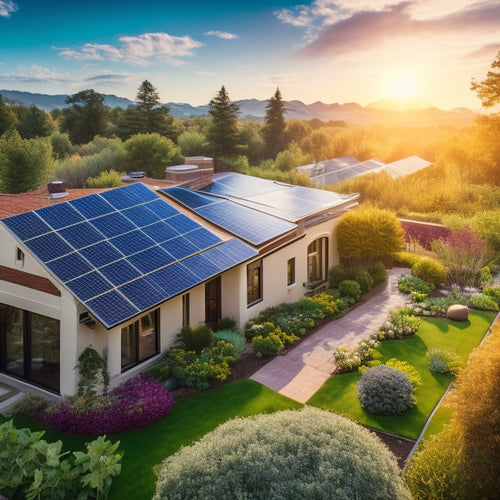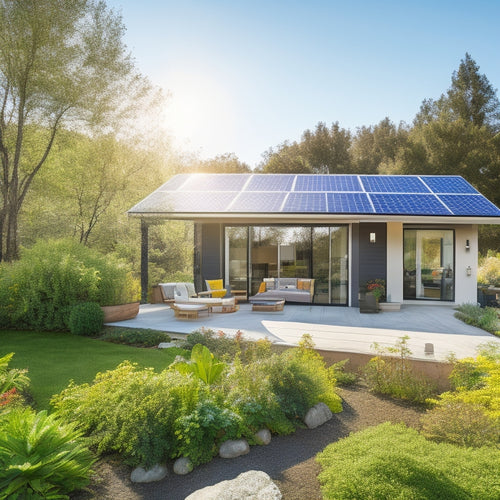
Solar Panel Cost: How Much per Watt?
Share
In the United States, the cost of solar panels ranges from $2.50 to $3.50 per watt. Factors like material quality, efficiency, and installation complexity play significant roles in determining this price. High-efficiency panels with advanced technology typically cost more. Local labor rates and geographical variations also impact overall expenses. Evaluating manufacturers' cost per watt, efficiency ratings, and warranty terms helps in making informed decisions. Federal and state incentives can reduce upfront costs, further enhancing affordability. For deeper insights into installation costs, long-term savings, and purchasing options, there's much more to uncover.
Key Takeaways
- Average cost per watt for solar panels in the US ranges from $2.50 to $3.50.
- Material quality and panel efficiency significantly influence the cost per watt.
- Installation complexity and local labor rates can affect the overall cost per watt.
- Geographical variations and market trends play a role in the pricing of solar panels.
- Federal and state incentives can reduce the effective cost per watt of solar panels.
Factors Influencing Cost
https://www.youtube.com/watch?v=DSpNHtFWcn0
Several key factors directly influence the cost of solar panels, including material quality, installation complexity, and local labor rates. When you look at material quality, panel efficiency becomes essential. High-efficiency panels, which convert more sunlight into electricity, often use advanced technologies and premium materials, driving up costs. However, their superior energy output can provide long-term savings, making them a desirable investment despite the initial expense.
Installation complexity also plays a significant role. Your roof's design, angle, and any necessary structural modifications can affect labor costs and installation time. A straightforward installation on a flat roof will generally cost less than on a steep, multi-faceted roof. Additionally, local labor rates vary significantly, with urban areas typically charging more due to higher living costs.
Market demand is another critical factor. When demand for solar panels is high, prices tend to rise due to increased competition for available units. Conversely, when demand drops, manufacturers may lower prices to stimulate sales. Staying informed about current market trends can help you make a cost-effective choice.
Average Cost per Watt
When evaluating solar panel costs, you'll often encounter pricing expressed as the average cost per watt, which provides a vital measure for comparing different systems. On average, the cost per watt in the United States ranges from $2.50 to $3.50. However, this figure can vary greatly due to geographical variations and market trends.
Geographical variations play an important role in determining the cost per watt. For instance, in states like California and New York, where solar adoption is high, economies of scale may drive costs down. Conversely, in regions with less solar penetration, prices can be higher due to lower competition and less mature market infrastructure.
Market trends also impact the average cost per watt. Advances in solar technology, increased manufacturing efficiencies, and fluctuations in raw material costs can all influence pricing.
For example, a surge in silicon prices or supply chain disruptions could temporarily increase costs. Conversely, improvements in panel efficiency, spurred by technological innovation, often drive prices downward over time.
Comparing Manufacturers
To make an informed decision, it's crucial to compare manufacturers based on their cost per watt, efficiency ratings, and warranty terms. Start by evaluating brand reputation. Established manufacturers like SunPower, LG, and Panasonic have consistent performance records, often reflected in higher initial costs but superior long-term value. These brands typically offer higher efficiency ratings, meaning you'll get more energy output per watt, maximizing your investment.
Next, scrutinize warranty coverage. Leading brands provide extensive warranties that cover both product and performance. A 25-year warranty is standard for top-tier brands, ensuring that your panels will maintain a high efficiency over an extended period. Compare this with lesser-known manufacturers, which might offer shorter, less thorough warranties, potentially increasing your long-term risk.
Efficiency ratings are another important factor. High-efficiency panels, such as those from SunPower, can exceed 22% efficiency, while more affordable options may hover around 15-17%. While lower efficiency panels might save you money upfront, they require more space and may not deliver the same energy yield over time.
Installation Expenses
When considering installation expenses, you should examine labor and permitting fees, which often account for 10-20% of the total cost.
Additionally, equipment and material costs, including mounting hardware and wiring, can have a considerable impact on your budget.
Accurately estimating these expenses will help you understand the full financial scope of your solar panel project.
Labor and Permitting Fees
How much do labor and permitting fees contribute to the overall installation expenses of solar panels? These costs can greatly impact your budget.
Labor rates vary by region and experience level, while permit delays can stretch out your timeline and inflate costs.
-
Labor Rates: On average, labor costs account for about 10-15% of the total installation expenses. Skilled electricians and installers charge between $30 to $50 per hour.
-
Permitting Fees: Depending on your local regulations, permitting fees can range from $100 to $300. Certain jurisdictions may have additional requirements, adding to the complexity and cost.
-
Permit Delays: Delays in obtaining permits can add weeks to your installation timeline, potentially increasing labor costs due to extended project durations.
- Administrative Costs: Additional administrative tasks, such as coordinating inspections and paperwork, can also add to the total cost, typically contributing another 1-2%.
These factors are essential to keep in mind if you aim to manage your solar panel installation budget effectively. By understanding the impact of labor and permitting fees, you can make informed decisions and avoid unexpected expenses.
Detailed planning and consultation with local experts can help mitigate these costs, freeing you from financial surprises and ensuring a smoother installation process.
Equipment and Material Costs
Equipment and material costs constitute a significant portion of the total expenses for solar panel installation, typically accounting for 50-60% of the overall budget. When you invest in solar panels, you're primarily paying for the panels themselves, inverters, mounting hardware, and wiring.
The importance of the panels is vital; higher efficiency panels might cost more upfront but generate more electricity, offering better long-term savings.
Material quality also plays a pivotal role. Premium materials guarantee durability and sustained performance, reducing the likelihood of costly repairs or replacements. For instance, monocrystalline panels, known for their high efficiency and longevity, tend to be more expensive than polycrystalline alternatives but can be more cost-effective over time.
Inverters, which convert the generated DC electricity into AC electricity for home use, vary in price based on their type and efficiency. String inverters are generally cheaper but less efficient compared to microinverters.
Incentives and Rebates
Government incentives and rebates can greatly reduce the upfront cost of installing solar panels. Federal incentives, like the Investment Tax Credit (ITC), allow you to deduct a significant percentage of your solar installation cost from your federal taxes. In 2023, the ITC offers a 26% tax credit for residential installations. This means if your system costs $10,000, you can subtract $2,600 from your tax bill, effectively lowering your initial investment.
State and local rebate programs also play an important role in making solar more affordable.
-
State Incentives: Some states offer additional tax credits that stack with federal incentives, enhancing your savings.
-
Local Rebates: Many utilities provide rebates to encourage solar adoption, often reducing costs by hundreds or thousands of dollars.
-
Performance-Based Incentives: Programs like Solar Renewable Energy Certificates (SRECs) compensate you for the power your system generates, providing ongoing financial benefits.
- Sales Tax Exemptions: Several states exempt solar installations from sales tax, trimming a few more percentage points off your total cost.
These incentives and rebates empower you to take control of your energy future, making solar power a more accessible and financially viable option.
Long-term Savings
Beyond the immediate financial relief from incentives and rebates, homeowners can expect substantial long-term savings by reducing their reliance on traditional energy sources. By investing in solar panels, you're integrating energy efficiency into your home, which directly translates into lower utility bills.
According to the National Renewable Energy Laboratory (NREL), the average residential solar panel system can save homeowners between $10,000 and $30,000 over its 25- to 30-year lifespan, depending on the local cost of electricity.
The savings aren't just limited to your monthly energy bill. Solar panels can also increase the resale value of your home. A study by the Lawrence Berkeley National Laboratory found that homes with solar energy systems sell for about 4.1% more than comparable non-solar homes. This means your investment in energy efficiency doesn't just pay off in monthly savings—it also boosts your home's market value.
Furthermore, solar panels require minimal maintenance and have a long lifespan, ensuring that your future savings are both substantial and sustainable.
Purchasing Online
When purchasing solar panels online, you'll need to compare prices across various retailers to make sure you're getting the best deal.
Additionally, consider the shipping and handling fees, as these can greatly impact the overall cost.
Analyzing these factors helps you make a more informed and cost-effective decision.
Comparing Online Retailers
In today's market, comparing online retailers for purchasing solar panels reveals significant differences in price, warranty, and customer service. To make a well-informed decision, you need to evaluate several factors systematically.
Brand reputation and customer reviews are essential in determining the reliability and performance of the solar panels you intend to buy. Established brands often come with proven track records, while lesser-known brands might offer competitive pricing but lack thorough feedback.
To aid your comparison, consider the following key points:
-
Price per Watt: Assess the cost efficiency by comparing the price per watt among different retailers.
-
Warranty Terms: Examine the length and coverage of warranties. Longer warranties often indicate higher confidence in product durability.
-
Customer Reviews: Look at customer reviews to gauge satisfaction levels. High ratings and positive feedback often correlate with better service and product quality.
- Brand Reputation: Evaluate the brand's market standing. Established brands often provide more reliable and efficient panels.
Shipping and Handling Fees
Shipping and handling fees can greatly impact the total cost of purchasing solar panels online, so it's important to evaluate these charges carefully. When calculating the overall expense, consider the weight and dimensions of the panels, as these factors directly influence shipping costs.
Bulk orders often result in lower per-panel shipping costs, as vendors frequently offer discounts for larger quantities. However, make sure the savings align with your installation needs and storage capabilities.
International shipping adds another layer of complexity. Customs duties, import taxes, and longer transit times can greatly raise the final cost. It's crucial to review these potential fees upfront to avoid unexpected expenses. Some online retailers provide shipping calculators that give you the ability to estimate costs based on your location and order size.
Technical specifications, such as the fragility and sensitivity of solar panels, necessitate specialized packaging and handling procedures. These measures, while ensuring the safe arrival of your panels, can also contribute to the shipping fees. Therefore, evaluate whether the retailer's shipping and handling protocols justify the additional costs.
Frequently Asked Questions
How Do Solar Panels Affect Home Resale Value?
Imagine revealing your home's hidden potential. Solar panels can greatly enhance your appraisal value and provide compelling buyer incentives. Studies show homes with solar panels often sell faster and at higher prices, liberating your financial future.
What Is the Lifespan of a Typical Solar Panel?
You're looking at a typical solar panel lifespan of 25-30 years. With a degradation rate of about 0.5-1% annually, manufacturers often offer a warranty period of 25 years, ensuring consistent performance and long-term reliability.
Are There Maintenance Costs Associated With Solar Panels?
You might be surprised, but yes, there are maintenance costs. You'll need cleaning services to keep them efficient and occasional inverter replacement. These costs are minimal compared to the long-term savings and energy independence you'll gain.
Can Solar Panels Work During Cloudy or Rainy Days?
Yes, solar panels can work during cloudy or rainy days. While weather impacts efficiency, energy storage systems guarantee consistent power supply. On overcast days, solar panels produce 10-25% of their usual output, maintaining some energy generation.
How Does Solar Panel Efficiency Impact Overall Cost?
You might think higher efficiency ratings don't justify the cost, but they reduce installation costs by needing fewer panels. More efficient panels maximize energy output, ultimately lowering your total investment and freeing you from high energy bills.
Related Posts
-

Sustainable Solar Energy for Cost-Effective Living
Adopting sustainable solar energy isn't just eco-friendly; it's a smart financial strategy. You'll slash your monthly...
-

Green Home Improvements Using Solar Power
Investing in solar power alters your home into a sustainable haven while slashing energy costs. You can greatly reduc...
-

Long-Term Cost Savings With Solar Panels
Investing in solar panels offers substantial long-term savings on energy costs. You'll benefit from federal tax credi...


